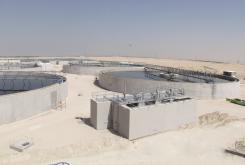PFAS remediation is becoming more urgent for industry, municipal water facilities

Per-and poly-fluoroalkyl substances, better known as PFAS, are present in many products consumers use daily - from certain food packaging and cleaning products to cosmetics and more. As a result, concerns around PFAS contamination levels and negative health effects have garnered significant media attention and driven increasing pressure to impose stricter regulations around the world.
Last year, the EPA introduced updated effluent guidelines planned to more fully address wastewater discharge in the United States, including the first limits for PFAS. The EPA also has a non-enforceable health advisory level of 70 parts per trillion (ppt) for the sum of perfluorooctanoic acid (PFOA) and perfluorooctane sulfonate (PFOS) in drinking water, but some existing maximum contaminant levels (MCLs) are still above that threshold.
Globally, regulations are even more wide-ranging. China, Canada, and the EU have led the way in enforceable limits. In contrast, signatory countries of the Stockholm Convention on Persistent Organic Pollutants (POPs) have focused on aqueous firefighting foams (AFFF) often stored in outdoor tanks or ponds in particular.
Water and wastewater treatment plant managers need to be acutely aware of the differences between statutory PFAS regulations and PFAS guidelines, and also understand that non-regulatory guidelines may become statutory in the future.
Expansion of regulations, awareness driving shift in enforcement
While stricter federal regulations are anticipated in the future, the timeline and specifics around the regulations are still uncertain. In anticipation of these changes, state-level wastewater regulation agencies are taking action by requiring sampling and testing in advance of imposing stricter rules ahead of the coming federal decisions.
In Minnesota, there are already certain requirements to conduct testing and report many pollutants. The Minnesota Pollution Control Agency (MCPA) developed a PFAS Monitoring Plan to incorporate these contaminants, specifically noting that changes may need to be made to comply with evolving PFAS regulations at both the state and federal levels.
Similarly, refineries and petrochemical plants would historically dilute their Aqueous Film Forming Foam (AFFF) ponds, containing firefighting foam left from a fire event, to the EPA’s recommended level of 70 ppt before discharging it into wastewater streams. Now, agencies are starting to prohibit wastewater streams with any level of PFAS to be discharged at all.
The need for PFAS remediation is more apparent than ever, and industrial plants need to take action to address PFAS contamination more urgently than the speed at which the regulatory landscape is developing. As such, industrial plants are asking for help managing and remediating PFAS to comply with these tightening regulations.
Evaluating solutions for PFAS treatment
Just as PFAS regulations vary across the board, PFAS challenges are also uniquely complex at each site, meaning the most effective flowsheet can differ significantly between projects. A treatment flowsheet developed from a holistic standpoint regards the unit operations as a complete system—technically and economically optimized as a full package, not as individual parts. This flowsheet will provide the context necessary to balance the trade-offs of different treatment processes to assemble the ideal combination of technologies to treat targeted PFAS, where the choice of one option will influence the performance or the selection of another downstream.
Many factors must be considered to identify the best treatment solution for addressing PFAS at your site. These include:
● PFAS constituents to be treated. Understanding PFAS characteristics like chain length, functional groups, the number of compounds, and variability guides the evaluation and selection of technologies for the final treatment flowsheet.
● Competing contaminants like high concentrations of salts, suspended solids, innocuous organics, or other contaminants of concern in industrial wastewaters can impact treatment equipment and processes.
● Lifecycle costs are impacted by the level of treatment and technology selection, the method for managing captured PFAS and its final disposal along with any associated costs for replacing spent media.
● Site constraints related to disposal and treatment and/or technology solution.
● Technology limitations should be carefully weighed for each potential solution during the selection process.
Once analytical lab testing to determine what substances are present at your site is complete, there are three PFAS treatment categories to consider. Separation treatment technologies include proven membranes like reverse osmosis (RO) and nanofiltration (NF), which are increasingly being used to address PFAS. Capture treatment technologies include activated carbon (widely used to date), anion exchange resin (receiving increasing interest), and novel adsorbents. PFAS disposal technologies can include thermal oxidation and incineration, electrochemical oxidation, and/or high energy technology such as plasma.
Industrial plants can deploy multiple technologies depending on their situation. Granular activated carbon (GAC) is a proven technology used throughout the world and is very effective at capturing many common forms of PFAS but it is not as effective on shorter chains. GAC can also be reactivated and used again. While the cost for GAC reactivation is less than incineration, care must be taken not to release or produce PFAS as part of the reactivation process. Ion exchange is an effective technology on both long- and short-chain compounds and maintains a high throughput capacity with a modest footprint. Still, it requires extensive pretreatment and most applications require piloting. Plants may not have the time or budget for that. Treating PFAS with membrane technology provides a larger host of options, especially high-pressure membranes (reverse osmosis, nanofiltration) that are highly effective at PFAS removal and provide future-proofing benefits. After implementing a solution, additional testing and monitoring should be conducted to ensure continued compliance.
Above all, maintain a holistic view of PFAS reductions
PFAS treatment solutions are not one size fits all. Industrial companies that recognize this have an advantage in staying ahead of the evolving PFAS regulations. Developing a treatment plan that allows for flexibility is key to navigating the adapting regulatory landscape, mitigating PFAS, and future-proofing your plant.
Learn how Veolia | Water Tech can assist you in creating and executing a tailored, future-proof treatment plan for PFAS mitigation here.







